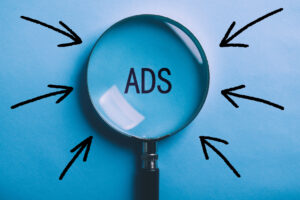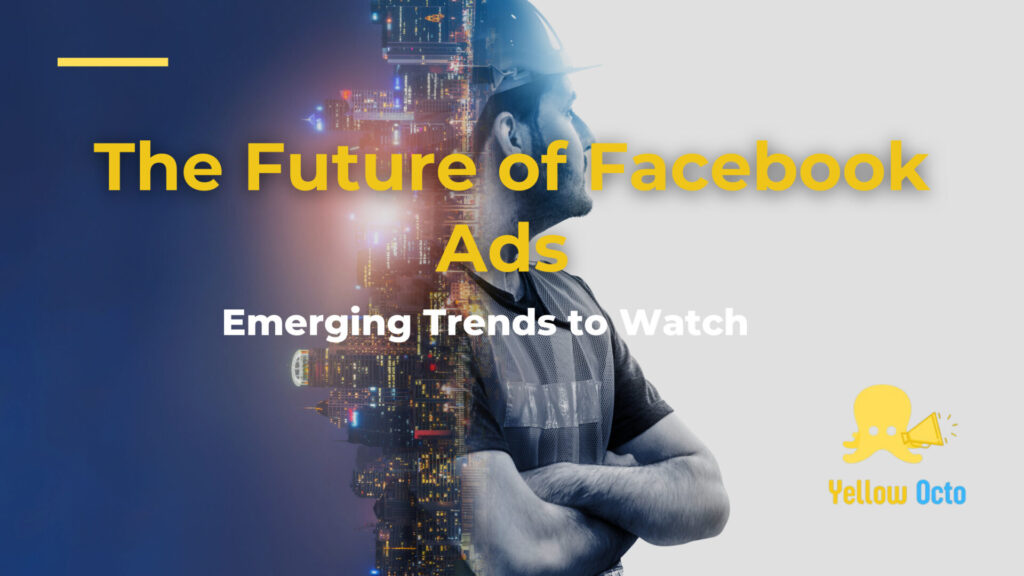The Future of Facebook Ads: Emerging Trends to Watch
1. Introduction
As one of the most dominant players in the digital advertising landscape, Facebook Ads continues to evolve and shape the future of performance marketing. From the rise of Meta Ads and the competition with Google Ads to the growing importance of performance-based marketing and the emergence of specialized B2B performance marketing agencies, there are several key trends that marketers need to watch.
Want to stay updated on the latest trends? Schedule a free call with Yellow Octo!
In this blog, we will explore the future of Facebook Ads and discuss the emerging trends that will impact the industry. Whether you are a business owner, marketer, or digital strategist, staying informed about the latest developments in Facebook Ads is crucial for success in the ever-changing world of digital advertising.
2. The evolution of Facebook ads
Over the years, Facebook Ads has undergone significant evolution, transforming from a simple platform for connecting friends and sharing content to a powerful advertising tool that can reach billions of users worldwide. This evolution has been driven by advancements in technology, changes in consumer behavior, and the ongoing drive for innovation within the digital advertising industry.

One of the most noticeable evolutions in Facebook Ads has been the introduction of new ad formats and targeting capabilities. Marketers can now choose from a wide range of ad formats, including video ads, carousel ads, and collection ads, to create more engaging and interactive experiences for their target audience. Additionally, Facebook has continuously improved its targeting options, allowing marketers to reach specific segments of their audience based on demographics, interests, and behaviors.
Another key aspect of the evolution of Facebook Ads is the emphasis on performance-based marketing. As businesses strive to maximize their return on investment, Facebook has introduced new metrics and measurement tools to help advertisers track and optimize their campaign performance. From conversion tracking to split testing, these tools provide invaluable insights into the effectiveness of Facebook Ads and enable advertisers to make data-driven decisions.
Furthermore, Facebook has recognized the growing importance of mobile advertising and has tailored its ad formats and targeting options to better suit the mobile-first mindset of its users. With the majority of Facebook users accessing the platform via mobile devices, advertisers can now leverage features like mobile app install ads, lead ads, and dynamic ads to capture the attention of their mobile audience effectively.
Looking ahead, the evolution of Facebook Ads is likely to continue, driven by advancements in artificial intelligence, augmented reality, and the integration with Meta’s Metaverse. These emerging technologies will offer marketers new ways to create immersive and personalized ad experiences, further blurring the lines between the physical and digital worlds.
3. Trend 1: Increasing importance of video ads
As we look towards the future of Facebook Ads, one emerging trend that advertisers must pay attention to is the increasing importance of video ads. Video content has become incredibly popular among users, with platforms like YouTube and TikTok leading the way. Facebook has recognized this shift in consumer behavior and has made significant investments in its video ad capabilities.
 Video ads offer a unique opportunity for advertisers to tell their brand’s story in a visually compelling and engaging manner. They have the power to capture the attention of users and leave a lasting impression. With the rise of mobile usage, video ads also perform exceptionally well on mobile devices, ensuring that advertisers can reach their target audience wherever they are.
Video ads offer a unique opportunity for advertisers to tell their brand’s story in a visually compelling and engaging manner. They have the power to capture the attention of users and leave a lasting impression. With the rise of mobile usage, video ads also perform exceptionally well on mobile devices, ensuring that advertisers can reach their target audience wherever they are.
To cater to this trend, Facebook has introduced various video ad formats, such as in-stream video ads, Stories ads, and live video ads. These formats allow advertisers to deliver their messages in a way that seamlessly integrates with users’ browsing experience and ensures maximum impact.
In addition to the format, Facebook has also developed powerful targeting and measurement tools specifically for video ads. Advertisers can now target their video ads based on factors like interests, behaviors, and demographics, ensuring that their content reaches the most relevant audience. Furthermore, Facebook’s video ad metrics provide detailed insights into audience engagement, completion rates, and conversions, enabling advertisers to optimize their campaigns effectively.
As we move into the future, it’s clear that video ads will play a crucial role in Facebook’s ad ecosystem. Advertisers who embrace this trend and incorporate compelling video content into their campaigns will have a competitive edge in capturing the attention and engagement of their target audience.
4. Trend 2: Rise of personalized and interactive ads
As we delve deeper into the future of Facebook Ads, it’s essential to understand the increasing significance of personalized and interactive ads. Gone are the days of generic, one-size-fits-all advertising. Today’s consumers crave personalized experiences that resonate with their individual interests and preferences.
Facebook has recognized this shift in consumer behavior and has developed powerful tools and features to enable advertisers to deliver highly personalized and interactive ads. By leveraging user data and advanced targeting capabilities, advertisers can now create ads that speak directly to their target audience, increasing relevance and engagement.
One of the most effective ways to personalize ads on Facebook is through dynamic ads. These ads automatically populate content, such as product images and descriptions, based on the user’s browsing history and interests. This creates a tailored experience that increases the chances of conversion.

Additionally, interactive ads have gained significant traction on Facebook. These ads invite users to actively engage with the content through quizzes, polls, or interactive elements. By involving users in the ad experience, advertisers can create a deeper connection and foster a sense of interactivity and involvement.
Furthermore, Facebook’s ad platform offers robust measurement tools that allow advertisers to track the effectiveness of their personalized and interactive ads. By analyzing metrics such as click-through rates, engagement rates, and conversions, advertisers can continuously optimize their campaigns and ensure maximum ROI.
As we move forward, the rise of personalized and interactive ads will continue to shape the future of Facebook Ads. Advertisers who embrace this trend and invest in creating highly relevant and engaging ad experiences will stand out in a crowded marketplace, driving better results for their businesses.
5. Trend 3: Growing significance of mobile-first advertising
With the increasing dominance of mobile devices in our daily lives, it comes as no surprise that mobile-first advertising is becoming a critical trend to watch in the future of Facebook Ads. As more and more consumers rely on their smartphones and tablets for browsing, shopping, and socializing, advertisers must adapt their strategies accordingly.
Facebook has recognized this shift towards mobile and has developed a range of mobile-centric ad formats and features to help businesses effectively engage with their target audience. These include immersive, full-screen ads, carousel ads that showcase multiple products, and collection ads that provide a seamless shopping experience within the app.
Moreover, Facebook’s powerful targeting capabilities allow advertisers to reach their desired mobile audience with precision. From location-based targeting to interests and demographics, businesses can ensure that their ads are seen by the right people at the right time, maximizing their chances of driving conversions.
Additionally, Facebook provides comprehensive insights and analytics specifically for mobile ads, allowing advertisers to track important metrics such as mobile app installs, engagements, and purchases. This data empowers businesses to make data-driven decisions and optimize their mobile ad campaigns for better results.
As mobile usage continues to grow, advertisers who prioritize mobile-first advertising on Facebook will have a significant advantage in reaching and connecting with their target audience. By leveraging the platform’s mobile-centric features and targeting capabilities, businesses can stay ahead of the competition and drive success in the fast-paced mobile landscape.
6. Trend 4: Embracing augmented reality in ad campaigns
As we dive deeper into the future of Facebook Ads, another emerging trend that deserves attention is the integration of augmented reality (AR) in ad campaigns. AR technology has been steadily gaining momentum, and its potential for enhancing the advertising experience is becoming increasingly apparent.
Facebook, recognizing the power of AR, has introduced various tools and features to help advertisers leverage this cutting-edge technology. One such tool is Spark AR Studio, a platform that allows businesses to create interactive and immersive AR experiences for their target audience. With this tool, advertisers can bring their products and services to life in a whole new way, engaging users and sparking their interest.
Through AR ads, businesses can provide customers with virtual try-on experiences, allowing them to visualize how a product looks or fits before making a purchase. This not only enhances customer confidence but also reduces the likelihood of product returns, resulting in a more positive customer experience and increased conversions.
Furthermore, AR ads have the power to captivate and entertain users, making them more likely to engage with the content and share it with their networks. Users can interact with virtual objects, explore virtual spaces, and even play games within an ad, creating a memorable and enjoyable experience.
With augmented reality promising to revolutionize the way we interact with ads, businesses that embrace AR in their Facebook ad campaigns will be at the forefront of this transformation. By embracing this trend and incorporating AR elements into their ads, advertisers can capture the attention of their audience, build brand loyalty, and drive impressive results.
7. Trend 5: The era of influencer marketing on Facebook
In recent years, influencer marketing has taken the advertising world by storm, and Facebook is no exception to this trend. In fact, influencer marketing on Facebook is expected to continue its rise in the future. As consumers become increasingly wary of traditional advertisements, they turn to influencers for recommendations and authentic content.
The power of influencers lies in their ability to connect with their followers on a personal level. By collaborating with influencers who have a strong online presence and a dedicated fan base, businesses can tap into a highly engaged and targeted audience. Influencers can create sponsored posts, reviews, and demonstrations that seamlessly integrate with their content, making it feel more organic and trustworthy.
Facebook’s influencer marketing features, such as branded content tags and collaboration tools, make it easier than ever for advertisers to partner with influencers and track the performance of their campaigns. By leveraging the reach and influence of popular individuals within their target market, businesses can reach a wider audience and drive brand awareness.
Moreover, influencer marketing allows brands to leverage the expertise and credibility of influencers in their industry. By associating their products or services with trusted influencers, businesses can gain instant credibility and establish themselves as industry leaders.
As we look to the future of Facebook Ads, influencer marketing will continue to play a crucial role in driving successful campaigns. Businesses that understand this trend and effectively utilize influencer partnerships will have a competitive edge in reaching their target audience and achieving their marketing goals.
8. Conclusion: Preparing for the future of Facebook ads
The previous blog section discussed the growing trend of influencer marketing on Facebook and its significance in the advertising world. As we navigate through the future of Facebook Ads, it is essential for businesses to stay informed and adapt to emerging trends.
One trend that is shaping the future of Facebook Ads is the rise of video content. In the next section, we will delve into how video content can revolutionize your ad campaigns, capture the attention of your target audience, and drive higher engagement and conversions.
In conclusion, understanding the emerging trends in Facebook Ads is crucial for businesses to stay ahead of the competition and maximize their advertising efforts. By embracing influencer marketing and exploring the potential of video content, businesses can create impactful campaigns that resonate with their audience and drive meaningful results.

